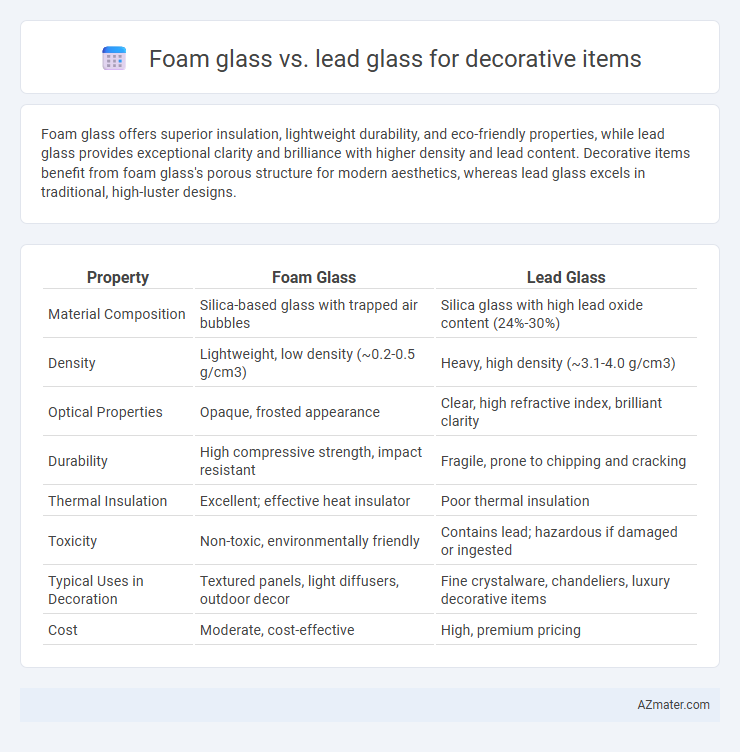Foam glass offers superior insulation, lightweight durability, and eco-friendly properties, while lead glass provides exceptional clarity and brilliance with higher density and lead content. Decorative items benefit from foam glass's porous structure for modern aesthetics, whereas lead glass excels in traditional, high-luster designs.
Table of Comparison
| Property | Foam Glass | Lead Glass |
|---|---|---|
| Material Composition | Silica-based glass with trapped air bubbles | Silica glass with high lead oxide content (24%-30%) |
| Density | Lightweight, low density (~0.2-0.5 g/cm3) | Heavy, high density (~3.1-4.0 g/cm3) |
| Optical Properties | Opaque, frosted appearance | Clear, high refractive index, brilliant clarity |
| Durability | High compressive strength, impact resistant | Fragile, prone to chipping and cracking |
| Thermal Insulation | Excellent; effective heat insulator | Poor thermal insulation |
| Toxicity | Non-toxic, environmentally friendly | Contains lead; hazardous if damaged or ingested |
| Typical Uses in Decoration | Textured panels, light diffusers, outdoor decor | Fine crystalware, chandeliers, luxury decorative items |
| Cost | Moderate, cost-effective | High, premium pricing |
Introduction to Decorative Glass Materials
Foam glass and lead glass serve distinct purposes in decorative applications, with foam glass prized for its lightweight, insulating properties and unique cellular texture, while lead glass is celebrated for its high refractive index and brilliance that enhances ornamental appeal. Foam glass offers durability and thermal resistance, making it suitable for architectural decorations that require both aesthetics and functionality. Lead glass, infused with lead oxide, provides exceptional clarity and sparkle, ideal for intricate decorative items like chandeliers and fine glassware.
Overview of Foam Glass
Foam glass is a lightweight, porous material made from crushed glass and foaming agents, offering excellent thermal insulation and high durability for decorative items. Its cellular structure provides resistance to moisture, fire, and chemicals, making it ideal for both indoor and outdoor decorative applications. Compared to lead glass, foam glass is more environmentally friendly and safer, lacking lead's toxicity while maintaining structural integrity and aesthetic versatility.
Overview of Lead Glass
Lead glass, also known as lead crystal, is prized for its high refractive index, which gives it exceptional brilliance and clarity, making it ideal for decorative items like vases, chandeliers, and fine glassware. Containing typically 24-30% lead oxide, lead glass is heavier and more durable than standard glass, enhancing its aesthetic appeal with a distinctive sparkle. Its ability to be intricately cut and engraved allows artisans to create detailed designs, making it a preferred material in luxury decorative pieces.
Aesthetic Differences: Foam Glass vs Lead Glass
Foam glass offers a distinctive matte, textured surface with a lightweight and porous structure that creates a modern, minimalist aesthetic, often resembling natural stone or frosted glass. Lead glass, in contrast, provides a brilliant, high-reflective clarity and weight, with rich brilliance and deep refractions of light, making it ideal for luxurious decorative pieces. The choice between foam glass and lead glass hinges on whether a designer prioritizes subtle, muted elegance or sparkling, ornate visual impact.
Durability and Strength Comparison
Foam glass offers exceptional durability due to its cellular structure, making it lightweight yet highly resistant to impact and compression, ideal for long-lasting decorative items. Lead glass, while prized for its brilliance and weight, is more prone to scratching and chipping, reducing its strength compared to foam glass. The compressive strength of foam glass surpasses that of lead glass, making it a superior choice for decorative pieces requiring both aesthetic appeal and robust longevity.
Weight and Handling Considerations
Foam glass weighs significantly less than lead glass, making it easier to handle and install in decorative applications where weight is a critical factor. Lead glass is denser and heavier due to its high lead content, which requires careful handling and stronger support structures to prevent damage or injury. The lightweight nature of foam glass enhances its suitability for intricate designs and large installations without compromising safety or ease of movement.
Safety and Environmental Impact
Foam glass offers enhanced safety due to its non-toxic composition and excellent insulation properties, reducing risks associated with heat and fire in decorative items. Lead glass contains toxic lead, posing health hazards through potential lead exposure and environmental contamination during production and disposal. Environmentally, foam glass is eco-friendly, made from recycled materials and fully recyclable, whereas lead glass presents significant environmental challenges due to lead pollution and difficulties in recycling.
Cost and Availability
Foam glass is generally more affordable and widely available due to its simple manufacturing process and abundant raw materials, making it a cost-effective choice for decorative items. Lead glass, prized for its clarity and brilliance, tends to be more expensive and less readily available because of the higher production costs and regulations surrounding lead content. Availability of foam glass benefits from global production facilities, whereas lead glass supply is limited by environmental restrictions and specialized craftsmanship.
Popular Decorative Applications
Foam glass is popular in decorative applications such as architectural panels, furniture inlays, and garden ornaments due to its lightweight, insulating properties, and unique cellular texture. Lead glass, valued for its high refractive index and clarity, is commonly used in chandeliers, fine glassware, and ornamental vases to enhance brilliance and light dispersion. Both materials serve distinct aesthetic and functional roles in interior design, where foam glass emphasizes texture and insulation, while lead glass highlights optical elegance and sparkle.
Choosing the Best Glass for Decorative Items
Foam glass offers lightweight, insulating properties and a unique cellular structure that provides durability and a modern aesthetic for decorative items. Lead glass, known for its high refractive index and clarity, creates brilliant sparkle and elegance, making it ideal for traditional luxury decorations. Choosing the best glass depends on the desired balance between insulation, weight, and visual brilliance in the decorative piece.

Infographic: Foam glass vs Lead glass for Decorative item
 azmater.com
azmater.com